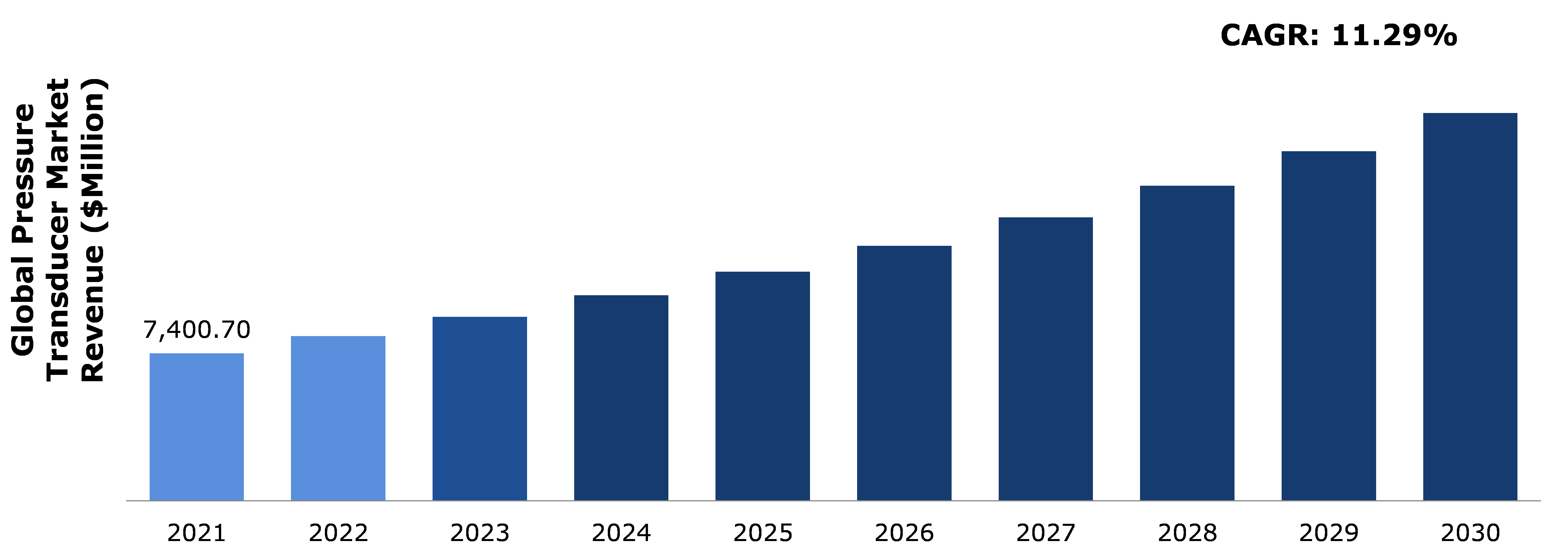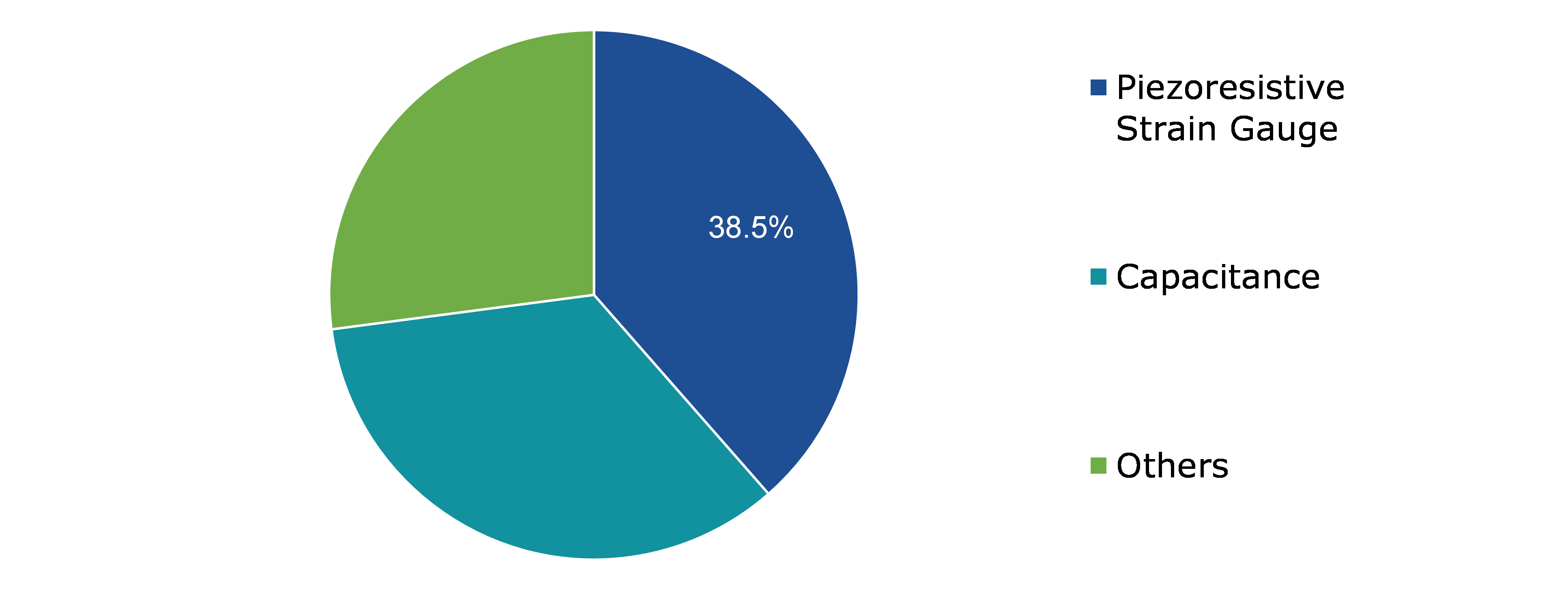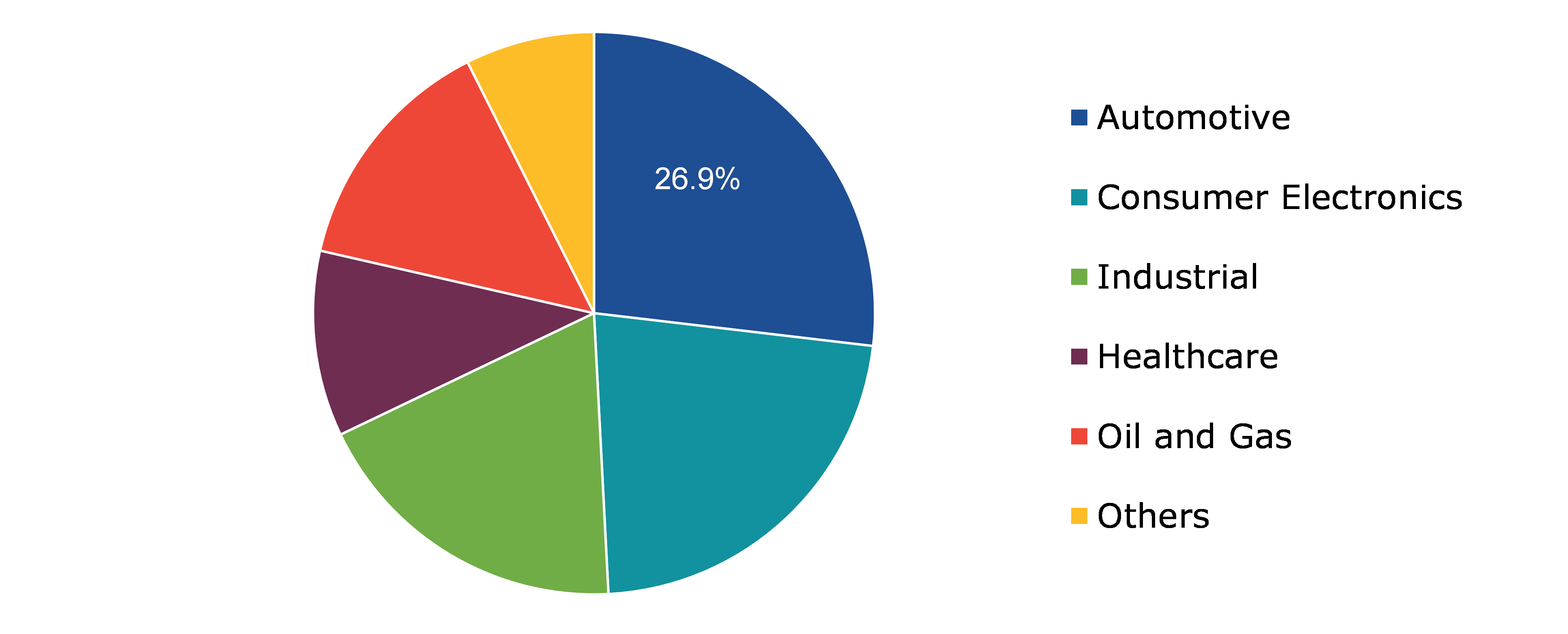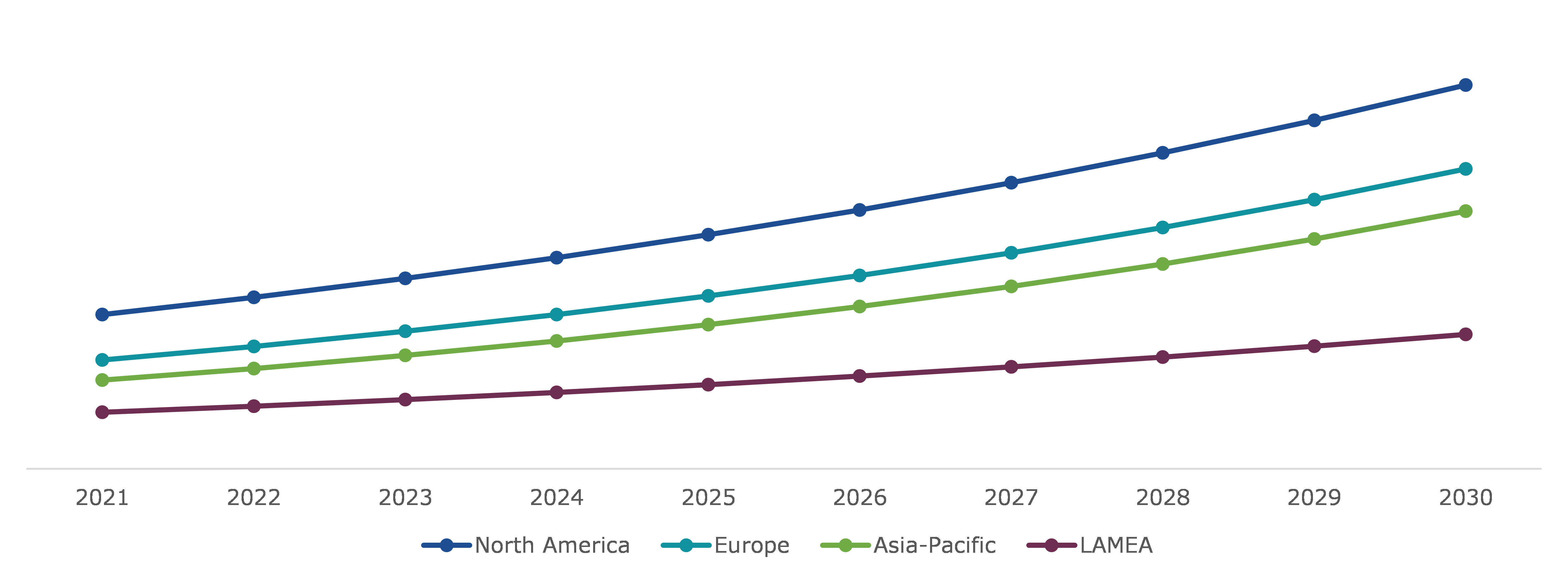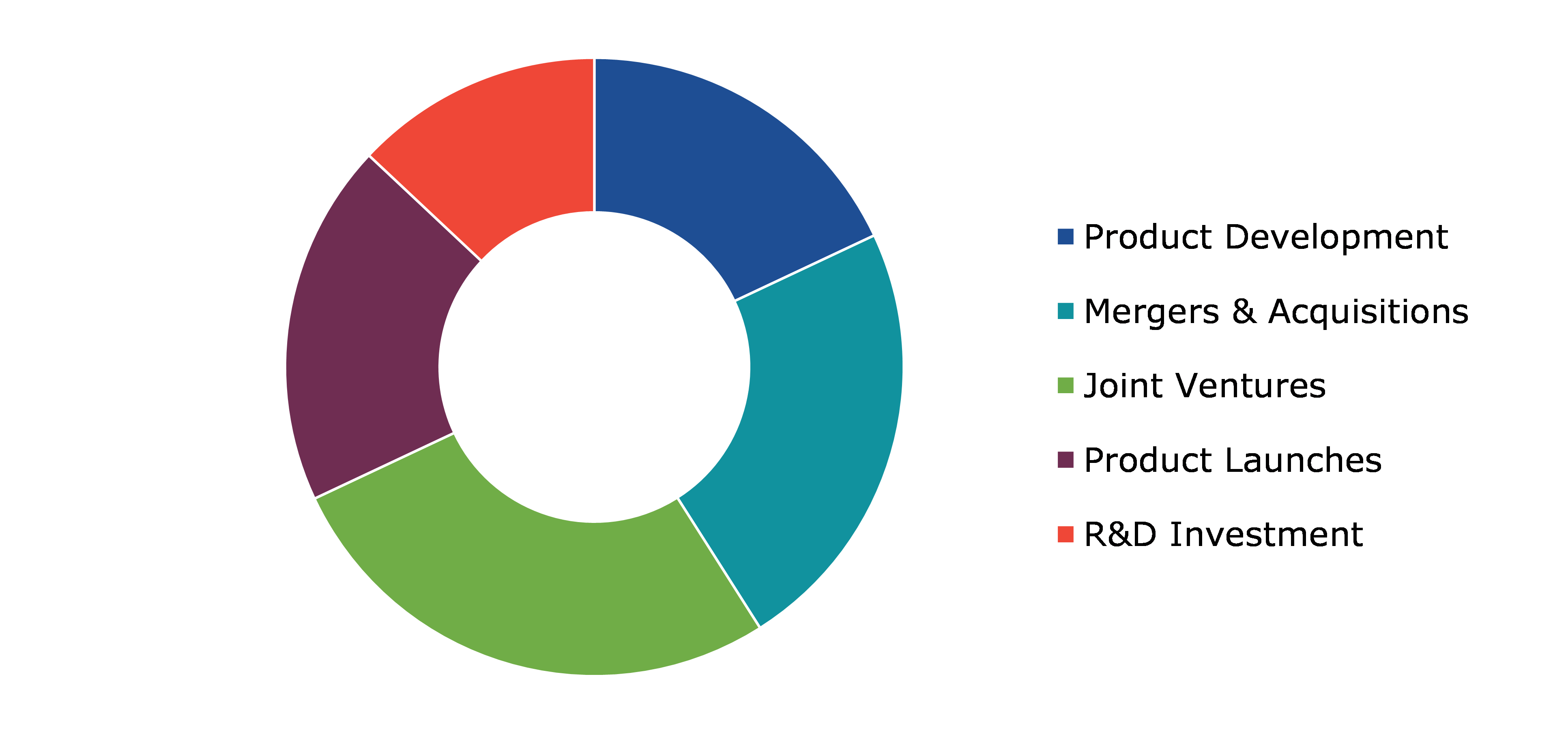Pressure Transducer Market Report
RA08519
Pressure Transducer Market by Technology Type (Piezoresistive Strain Gauge, Capacitance, and Others), Pressure Type (Absolute Pressure, Gauge Pressure, and Differential Pressure), End-use Industry (Automotive, Consumer Electronics, Industrial, Healthcare, Oil & Gas, and Others), and Regional Analysis (North America, Europe, Asia-Pacific, and LAMEA): Global Opportunity Analysis and Industry Forecast, 2022–2030
Global Pressure Transducer Market Analysis
The global pressure transducer market size was $7,400.7 million in 2021 and is predicted to grow with a CAGR of 11.29%, by generating a revenue of $19,466.1 million by 2030.
Global Pressure Transducer Market Synopsis
A pressure transducer is a device that transforms pressure into an analogue electrical signal. Although there are various types of pressure transducers such as absolute, gauge, differential, and multivariable transmitter, the strain-gage base transducer is one of the most prevalent. Pressure transducers generally offer three electrical output options: millivolt, amplified voltage, and 4-20mA.The automotive industry is under continuous innovation and is undergoing technology transition while focusing on comfort and safety which provides several opportunities for development of pressure sensors. Increasing use of pressure sensors in household appliances such as refrigerators and washing machines is driving demand for pressure sensors. Various market players such as Bosch Sensortec are focused on developing innovative technology for better customer experience such as BMP580, which is the new benchmark in the field of barometric pressure sensors as it has enormous accuracy.
Due to advancements in Information and Communication Technologies (ICT), pressure transducers are substituted by pressure transmitters for most of the applications and choosing transmitters over transducers has become increasingly attractive as the price for transmitters are lower compared to transducers.
Several market players in the electronics segments are developing new technologies in which pressure sensors are widely used because of the benefits including high accuracy, cost-effectiveness, and sensitive. These devices include smartphones, washing machines, gaming consoles, navigation systems, and other electronic devices. Among these devices, smartphone is the most used device integrated with pressure sensor to perform functions such as weather forecasting, navigation, level detection, and others. The barometric pressure sensor is majorly used in smartphones to measure air pressure to forecast weather. Increasing sensor-rich applications in drones, autonomous vehicles, and augmented reality (AR)/ Virtual reality (VR) equipment are further accelerating need for Microelectromechanical systems (MEMS) pressure sensors.
According to regional analysis, the market for pressure transducer in North America is most dominant market and accounted for $2,794.5 million in 2021 and is predicted to grow with a CAGR of 10.58% in the projected timeframe.
Pressure Transducer Overview
Pressure transducer is a device that engages in the conversion of pressure into an analogue electrical signal. Due to the prevalence of numerous pressure transducers in the market, one of the most prevalent is the strain-gage base transducer. The conversion of pressure to an electrical signal is performed with the assistance of the physical deformation of strain gauges, which are glued into the diaphragm of the pressure transducer and connected into a Wheatstone bridge arrangement. Pressure delivered to the pressure transducer normally creates a deflection of the membrane, which imparts strain to the gauges. The tension will cause an electrical resistance change that is precisely proportionate to the pressure.
COVID-19 Impact on Global Pressure Transducer Market
During the COVID-19 pandemic life of people and various industries across the globe was negatively affected and specifically the pressure transducer market suffered loss due to disruption in supply chains, unavailability of employees, and shut down of factories. Demand for pressure sensors was decreased from the covid-19 impact on pressure transducer market due to economic slowdown which had an adverse impact on the auto industry leading to decrease in demand and sales of pressure transducers. The global demand for automotive pressure sensors dropped significantly due to the COVID-19 lockdown in many countries around the world along with restrictions on international borders and implementation of rules by regulatory authorities. The COVID-19 pandemic changed the way people interacted and lived their life as there was decrease in usage of vehicle due to increased awareness regarding social distancing and restriction on public gathering and bans imposed on traveling. These factors are expected to hinder growth of the automotive pressure sensors market revenue over the forecast period.
Rising Demand for Industrial Automation and Optimal Pressure Type Utilization is Expected to Drive Market Growth
It is very critical to have appropriate level of process control and monitoring & maintaining process parameters in industrial automation. Industrial automation can improve product quality, lower the operational cost, and improve productivity, and addresses industrial health & safety issues across a wide range of process industries. The discrete and process industries have increased their efforts to implement best practices to reduce waste and improve plant efficiency. A pressure transmitter measures important parameters such as pressure, flow, and level on a continuous or periodic basis and these systems collect information from other instruments and the collected information is analyzed and used to enhance overall performance and productivity.
Intense Pricing Pressure on Major Market Players is Projected to Restrain Market Growth
Price erosion adversely affects the sales growth and increased shipment of pressure transducer in automated intelligent controls and wearable electronics due to intense competition in the pressure transducer market trend and increasing number of sensor manufacturers which forces rapid innovation in new portables and consumer products. The elements that are hindering market expansion of pressure transducer include frequent failures linked with pressure transducers. Generally, pressure transducers from renowned vendors vary only as little as 0.25% from the actual value. However, the improper combination of wiring of the gadget and mechanical connection might result in an extremely erroneous reading which is restraining the pressure transducer market growth in the forecasting years.
Increasing Demand for Automobiles will Offer Immense Growth Potential for Pressure Transducer Market
The automotive has emission control, battery control, and occupant detection applications sensor which are rapidly growing in recent years. Sensors in the automotive sectors are used to measure pressure inside pipes or chamber branching into several openings and outside air pressure which is drawn inside from the external area. There are various factors such as low automotive penetration, rising disposable incomes, and subsequent increase in vehicle adoption is predicted to drive revenue growth of this industry in APAC region and is expected to be significant in the coming years in the economies such as India and China. Since population is increasing across the globe, number of vehicles are also increasing along with the environmental and safety concerns which is leading to pressurizing governments into developing strict regulations on vehicle emission and safety standards. This eventually results in increasing number of vehicles equipped with various safety systems such as Exhaust Gas Recirculation (EGR), Anti-lock Braking System (ABS), and air bags all of which require pressure sensors to function. These factors are leading to rising demand from the automotive industry, which is further expected to drive revenue growth of the pressure transducer market analysis during the forecasting period.
Global Pressure Transducer Market, by Technology Type
Based on technology type, the market has been divided into piezoresistive strain gauge, capacitance, and others. Among these, the piezoresistive strain gauge sub-segment accounted for the highest market share in 2021, whereas the capacitance sub-type is estimated to show the fastest growth during the forecast period.
Global Pressure Transducer Market Share, by Technology Type, 2021
Source: Research Dive Analysis
The piezoresistive strain gauge sub-segment is anticipated to have a dominant market share and generate a revenue of $7,649.5 million by 2030, growing from $2,852.3 million in 2021. Piezoelectric pressure sensors are also known as strain gauge pressure measurement sensors, these pressure sensors operate on the piezoresistive effect. There has been an increase in demand for vehicles in developing countries and rise in the governmental concerns about safety standards are factors leading to growth in piezoresistive strain gauge and nanotechnology applications which is expected to have a positive impact on the market growth in the forecasting years. Introduction various products in piezoresistive strain gauge is also a growing trend among manufacturers of the pressure transducer.
The capacitance sub-type is anticipated to have the fastest growth and generate a revenue of $7,088.4 million by 2030, growing from $2,544.3 million in 2021. Capacitive pressure sensors detect changes in electrical capacitance caused by diaphragm movement. Due to advancements in Micro-electromechanical systems (MEMS) technology, reduction in the size of capacitive pressure sensors has increased applications in various range of industries. Since the size of capacitive pressure sensors has been reduced, the production cost has also decreased. The wide range of applications, high efficiency, and low cost are factors resulting in increased demand for capacitive pressure sensor.
Global Pressure Transducer Market, by Pressure Type
Based on pressure type, the market has been divided into absolute pressure, gauge pressure, and differential pressure. Among these, the absolute pressure sub-segment accounted for highest revenue share in 2021.
Global Pressure Transducer Market Share, by Pressure Type, 2021
Source: Research Dive Analysis
The absolute pressure sub-segment is anticipated to have a dominant market share and generate a revenue of $8,313.4 million by 2030, with an increase from $3,074.1 million in 2021. Absolute pressure sensor is a type of sensor used for absolute measurement of air or gas pressure by detecting target pressure relative to known pressure of an absolute vacuum. These sensors are widely employed in the vehicle sector to assess biometric pressure and tell powertrain control module about the engine load. These factors are influencing the market growth in the forecasting years.
The gauge pressure sub-segment is anticipated to have the fastest growth and surpass $7,479.1 million by 2030, with an increase from $2,720.5 million in 2021. Pressure gauges are used to measure fluid pressure in a range of applications. There has been a growing acceptance of the pressure gauges in various sectors such as in automotive as air pressure sensor, in healthcare as blood pressure devices, and others. These factors are projected to drive the pressure transducer market growth in the forecasting years.
Global Pressure Transducer Market, by End-use Industry
Based on end-use industry, the market has been divided into automotive, consumer electronics, industrial, healthcare, oil & gas, and others. Among these, the automotive sub-segment accounted for highest revenue share in 2021.
Global Pressure Transducer Market Share, by End-use Industry, 2021
Source: Research Dive Analysis
The automotive sub-segment in the global pressure transducer market is anticipated to have a dominant market share and surpass $4,894.7 million by 2030, with an increase from $1,988 million in 2021. There has been rise in demand for passenger vehicles, which is leading to economic growth along with adoption of advanced automotive technologies such as TPMS, ABS, ESC, and airbags, which is expected to drive the automotive sub-segment revenue growth. Increase in disposable income and increase in vehicle adoption in emerging economies such as India along with exponential production of electric vehicles in China is predicted to have an important impact on revenue growth of automotive pressure sensors market.
The industrial sub-segment is anticipated to have the fastest growth and surpass $4,092.3 million by 2030, with an increase from $1,385.2 million in 2021. A pressure sensor is a device designed to evaluate the particular pressure of a physical medium, often a gas or liquid, but it may also be a pressure applied by direct contact between the sensor and a solid object. Industrial pressure sensors are manufactured with a sturdy (typically metallic) enclosure that is resistant to physical damage and corrosion from components such as liquids and gases. They are also engineered to be very resistant to any electrical influences from outside their enclosure. Electrical and pressure connection fittings are also strong and resistant to any kind of harm.
Global Pressure Transducer Market, Regional Insights
The pressure transducer market was investigated across North America, Europe, Asia-Pacific, and LAMEA.
Global Pressure Transducer Market Size & Forecast, by Region, 2021-2030 (USD Million)
Source: Research Dive Analysis
The Market for Pressure Transducer in North America to be the Most Dominant
The North America pressure transducer market accounted $2,794.5 million in 2021 and is projected to grow with a CAGR of 10.58%. A device’s performance can be analyzed from the information that is collected, measured, and transmitted by a pressure sensor. Demand for pressure sensors market has been rising exponentially due to use of pressure sensors in various applications such as EGR system exhaust gas pressure. Government regulations on integrating pressure sensor in automobiles due to the rising safety standards implementation which have contributed to increase in demand for pressure transducer. Along with these factors safety mandates in North America is the major driver influencing revenue growth of the pressure transducer market in this region.
The Market for Pressure Transducer in Asia-Pacific to be the Most Lucrative
The Asia-Pacific pressure transducer market forecast accounted $1,606.7 million in 2021 and is projected to grow with a CAGR of 12.5%. Due to the presence of significant market players, technological advances, and the rise of process industries in the area, the market is likely to observe growth. The Asia-Pacific pressure transducer market is expected to grow favorably during the forecast period as a result of the adoption of industrial automation and optimum utilization to achieve high-performance efficiencies to achieve optimization and reduce performance failures in the automated industry.
Competitive Scenario in the Global Pressure Transducer Market
Investment and agreement are common strategies followed by major market players. For instance, in June 2018, ABB acquired GE Industrial Solutions (GEIS) for enhancing its position in electrification and expanding its presence in the North America region.
Source: Research Dive Analysis
Some of the leading pressure transducer market players are Panasonic Corporation, Sensata Technologies, Inc, ABB Ltd, Honeywell International Inc, Validyne Engineering, Robert Bosch Gmbh, NXP semiconductors, Setra Systems, Inc. (Fortive), ControlAir, Inc., and Kulite Semiconductor Products Inc.
| Aspect | Particulars |
| Historical Market Estimations | 2020-2021 |
| Base Year for Market Estimation | 2021 |
| Forecast Timeline for Market Projection | 2022-2030 |
| Geographical Scope | North America, Europe, Asia-Pacific, and LAMEA |
| Segmentation by Technology Type |
|
| Segmentation by Pressure Type |
|
| Segmentation by Pressure End-use |
|
|
Key Companies Profiled |
|
Q1. What is the size of the global pressure transducer market?
A. The size of the global pressure transducer market was over $7,400.7 million in 2021 and is projected to reach $19,466.1 million by 2030.
Q2. Which are the major companies in the pressure transducer market?
A. Panasonic Corporation, Sensata Technologies, Inc, ABB Ltd, Honeywell International Inc, Validyne Engineering, Robert Bosch Gmbh, NXP semiconductors, Setra Systems, Inc. (Fortive), ControlAir, Inc., and Kulite Semiconductor Products Inc. are some of the key players in the global pressure transducer market.
Q3. Which region, among others, possesses greater investment opportunities in the near future for Pressure Transducer market?
A. The Asia-Pacific region possesses great investment opportunities for investors to witness the most promising growth in the future.
Q4. What will be the growth rate of the Asia-Pacific pressure transducer market?
A. Asia-Pacific pressure transducer market is anticipated to grow at 12.5% CAGR during the forecast period.
Q5. What are the strategies opted by the leading players in Pressure Transducer market?
A. Product innovations, technological advancements, and business expansions are the key strategies opted by the operating companies in this market.
Q6. Which companies are investing more on R&D practices for pressure transducer market?
A. NXP semiconductors, Sensata Technologies, Inc, ABB Ltd, and Honeywell International Inc., are some of the major companies are investing more on R&D practices.
1.Research Methodology
1.1.Desk Research
1.2.Real time insights and validation
1.3.Forecast model
1.4.Assumptions and forecast parameters
1.5.Market size estimation
1.5.1.Top-down approach
1.5.2.Bottom-up approach
2.Report Scope
2.1.Market definition
2.2.Key objectives of the study
2.3.Report overview
2.4.Market segmentation
2.5.Overview of the impact of COVID-19 on Global Pressure Transducer Market
3.Executive Summary
4.Market Overview
4.1.Introduction
4.2.Growth impact forces
4.2.1.Drivers
4.2.2.Restraints
4.2.3.Opportunities
4.3.Market value chain analysis
4.3.1.List of raw material suppliers
4.3.2.List of manufacturers
4.3.3.List of distributors
4.4.Innovation & sustainability matrices
4.4.1.Technology matrix
4.4.2.Regulatory matrix
4.5.Porter’s five forces analysis
4.5.1.Bargaining power of suppliers
4.5.2.Bargaining power of consumers
4.5.3.Threat of substitutes
4.5.4.Threat of new entrants
4.5.5.Competitive rivalry intensity
4.6.PESTLE analysis
4.6.1.Political
4.6.2.Economical
4.6.3.Social
4.6.4.Technological
4.6.5.Environmental
4.7.Impact of COVID-19 on Pressure Transducer Market
4.7.1.Pre-covid market scenario
4.7.2.Post-covid market scenario
5.Pressure Transducer Market Analysis, by Technology Type
5.1.Overview
5.2.Piezoresistive Strain Gauge
5.2.1.Definition, key trends, growth factors, and opportunities, 2021-2030
5.2.2.Market size analysis, by region, 2021-2030
5.2.3.Market share analysis, by country, 2021-2030
5.3.Capacitance
5.3.1.Definition, key trends, growth factors, and opportunities, 2021-2030
5.3.2.Market size analysis, by region, 2021-2030
5.3.3.Market share analysis, by country, 2021-2030
5.4.Others
5.4.1.Definition, key trends, growth factors, and opportunities, 2021-2030
5.4.2.Market size analysis, by region, 2021-2030
5.4.3.Market share analysis, by country, 2021-2030
5.5.Research Dive Exclusive Insights
5.5.1.Market attractiveness, 2021-2030
5.5.2.Competition heatmap, 2021-2030
6.Pressure Transducer Market Analysis, by Pressure Type
6.1.Absolute Pressure
6.1.1.Definition, key trends, growth factors, and opportunities, 2021-2030
6.1.2.Market size analysis, by region, 2021-2030
6.1.3.Market share analysis, by country, 2021-2030
6.2.Gauge Pressure
6.2.1.Definition, key trends, growth factors, and opportunities, 2021-2030
6.2.2.Market size analysis, by region, 2021-2030
6.2.3.Market share analysis, by country, 2021-2030
6.3.Differential Pressure
6.3.1.Definition, key trends, growth factors, and opportunities, 2021-2030
6.3.2.Market size analysis, by region, 2021-2030
6.3.3.Market share analysis, by country, 2021-2030
6.4.Research Dive Exclusive Insights
6.4.1.Market attractiveness, 2021-2030
6.4.2.Competition heatmap, 2021-2030
7.Pressure Transducer Market Analysis, by End-use
7.1.Automotive
7.1.1.Definition, key trends, growth factors, and opportunities, 2021-2030
7.1.2.Market size analysis, by region, 2021-2030
7.1.3.Market share analysis, by country, 2021-2030
7.2. Consumer Electronics
7.2.1.Definition, key trends, growth factors, and opportunities, 2021-2030
7.2.2.Market size analysis, by region, 2021-2030
7.2.3.Market share analysis, by country, 2021-2030
7.3.Industrial
7.3.1.Definition, key trends, growth factors, and opportunities, 2021-2030
7.3.2.Market size analysis, by region, 2021-2030
7.3.3.Market share analysis, by country, 2021-2030
7.4.Healthcare
7.4.1.Definition, key trends, growth factors, and opportunities, 2021-2030
7.4.2.Market size analysis, by region, 2021-2030
7.4.3.Market share analysis, by country, 2021-2030
7.5.Oil & Gas
7.5.1.Definition, key trends, growth factors, and opportunities, 2021-2030
7.5.2.Market size analysis, by region, 2021-2030
7.5.3.Market share analysis, by country, 2021-2030
7.6.Others
7.6.1.Definition, key trends, growth factors, and opportunities, 2021-2030
7.6.2.Market size analysis, by region, 2021-2030
7.6.3.Market share analysis, by country, 2021-2030
7.7.Research Dive Exclusive Insights
7.7.1.Market attractiveness, 2021-2030
7.7.2.Competition heatmap, 2021-2030
8.Pressure Transducer Market, by Region
8.1.North America
8.1.1.U.S.
8.1.1.1.Market size analysis, by Technology, 2021-2030
8.1.1.2.Market size analysis, by Pressure, 2021-2030
8.1.1.3.Market size analysis, by End-use, 2021-2030
8.1.2.Canada
8.1.2.1.Market size analysis, by Technology, 2021-2030
8.1.2.2.Market size analysis, by Pressure, 2021-2030
8.1.2.3.Market size analysis, by End-use, 2021-2030
8.1.3.Mexico
8.1.3.1.Market size analysis, by Technology, 2021-2030
8.1.3.2.Market size analysis, by Pressure, 2021-2030
8.1.3.3.Market size analysis, by End-use, 2021-2030
8.1.4.Research Dive Exclusive Insights
8.1.4.1.Market attractiveness, 2021-2030
8.1.4.2.Competition heatmap, 2021-2030
8.2.Europe
8.2.1.Germany
8.2.1.1.Market size analysis, by Technology, 2021-2030
8.2.1.2.Market size analysis, by Pressure, 2021-2030
8.2.1.3.Market size analysis, by End-use, 2021-2030
8.2.2.U.K.
8.2.2.1.Market size analysis, by Technology, 2021-2030
8.2.2.2.Market size analysis, by Pressure, 2021-2030
8.2.2.3.Market size analysis, by End-use, 2021-2030
8.2.3.France
8.2.3.1.Market size analysis, by Technology, 2021-2030
8.2.3.2.Market size analysis, by Pressure, 2021-2030
8.2.3.3.Market size analysis, by End-use, 2021-2030
8.2.4.Spain
8.2.4.1.Market size analysis, by Technology, 2021-2030
8.2.4.2.Market size analysis, by Pressure, 2021-2030
8.2.4.3.Market size analysis, by End-use, 2021-2030
8.2.5.Italy
8.2.5.1.Market size analysis, by Technology, 2021-2030
8.2.5.2.Market size analysis, by Pressure, 2021-2030
8.2.5.3.Market size analysis, by End-use, 2021-2030
8.2.6.Rest of Europe
8.2.6.1.Market size analysis, by Technology, 2021-2030
8.2.6.2.Market size analysis, by Pressure, 2021-2030
8.2.6.3.Market size analysis, by End-use, 2021-2030
8.2.7.Research Dive Exclusive Insights
8.2.7.1.Market attractiveness, 2021-2030
8.2.7.2.Competition heatmap, 2021-2030
8.3.Asia-Pacific
8.3.1.China
8.3.1.1.Market size analysis, by Technology, 2021-2030
8.3.1.2.Market size analysis, by Pressure, 2021-2030
8.3.1.3.Market size analysis, by End-use, 2021-2030
8.3.2.Japan
8.3.2.1.Market size analysis, by Technology, 2021-2030
8.3.2.2.Market size analysis, by Pressure, 2021-2030
8.3.2.3.Market size analysis, by End-use, 2021-2030
8.3.3.India
8.3.3.1.Market size analysis, by Technology, 2021-2030
8.3.3.2.Market size analysis, by Pressure, 2021-2030
8.3.3.3.Market size analysis, by End-use, 2021-2030
8.3.4.Australia
8.3.4.1.Market size analysis, by Technology, 2021-2030
8.3.4.2.Market size analysis, by Pressure, 2021-2030
8.3.4.3.Market size analysis, by End-use, 2021-2030
8.3.5.South Korea
8.3.5.1.Market size analysis, by Technology, 2021-2030
8.3.5.2.Market size analysis, by Pressure, 2021-2030
8.3.5.3.Market size analysis, by End-use, 2021-2030
8.3.6.Rest of Asia-Pacific
8.3.6.1.Market size analysis, by Technology, 2021-2030
8.3.6.2.Market size analysis, by Pressure, 2021-2030
8.3.6.3.Market size analysis, by End-use, 2021-2030
8.3.7.Research Dive Exclusive Insights
8.3.7.1.Market attractiveness, 2021-2030
8.3.7.2.Competition heatmap, 2021-2030
8.4.LAMEA
8.4.1.Brazil
8.4.1.1.Market size analysis, by Technology, 2021-2030
8.4.1.2.Market size analysis, by Pressure, 2021-2030
8.4.1.3.Market size analysis, by End-use, 2021-2030
8.4.2.Saudi Arabia
8.4.2.1.Market size analysis, by Technology, 2021-2030
8.4.2.2.Market size analysis, by Pressure, 2021-2030
8.4.2.3.Market size analysis, by End-use, 2021-2030
8.4.3.UAE
8.4.3.1.Market size analysis, by Technology, 2021-2030
8.4.3.2.Market size analysis, by Pressure, 2021-2030
8.4.3.3.Market size analysis, by End-use, 2021-2030
8.4.4.South Africa
8.4.4.1.Market size analysis, by Technology, 2021-2030
8.4.4.2.Market size analysis, by Pressure, 2021-2030
8.4.4.3.Market size analysis, by End-use, 2021-2030
8.4.5.Rest of LAMEA
8.4.5.1.Market size analysis, by Technology, 2021-2030
8.4.5.2.Market size analysis, by Pressure, 2021-2030
8.4.5.3.Market size analysis, by End-use, 2021-2030
8.4.6.Research Dive Exclusive Insights
8.4.6.1.Market attractiveness, 2021-2030
8.4.6.2.Competition heatmap, 2021-2030
9.Competitive Landscape
9.1.Top winning strategies, 2021
9.1.1.By strategy
9.1.2.By year
9.2.Strategic overview
9.3.Market share analysis, 2021
10.Company Profiles
10.1. Panasonic Corporation
10.1.1.Overview
10.1.2.Business segments
10.1.3.Product portfolio
10.1.4.Financial performance
10.1.5.Recent developments
10.1.6.SWOT analysis
10.2.Sensata Technologies, Inc.
10.2.1.Overview
10.2.2.Business segments
10.2.3.Product portfolio
10.2.4.Financial performance
10.2.5.Recent developments
10.2.6.SWOT analysis
10.3.ABB Ltd
10.3.1.Overview
10.3.2.Business segments
10.3.3.Product portfolio
10.3.4.Financial performance
10.3.5.Recent developments
10.3.6.SWOT analysis
10.4. Honeywell International Inc
10.4.1.Overview
10.4.2.Business segments
10.4.3.Product portfolio
10.4.4.Financial performance
10.4.5.Recent developments
10.4.6.SWOT analysis
10.5.Validyne Engineering
10.5.1.Overview
10.5.2.Business segments
10.5.3.Product portfolio
10.5.4.Financial performance
10.5.5.Recent developments
10.5.6.SWOT analysis
10.6. Robert Bosch Gmbh
10.6.1.Overview
10.6.2.Business segments
10.6.3.Product portfolio
10.6.4.Financial performance
10.6.5.Recent developments
10.6.6.SWOT analysis
10.7.NXP semiconductors
10.7.1.Overview
10.7.2.Business segments
10.7.3.Product portfolio
10.7.4.Financial performance
10.7.5.Recent developments
10.7.6.SWOT analysis
10.8.Setra Systems, Inc. (Fortive)
10.8.1.Overview
10.8.2.Business segments
10.8.3.Product portfolio
10.8.4.Financial performance
10.8.5.Recent developments
10.8.6.SWOT analysis
10.9.ControlAir, Inc.
10.9.1.Overview
10.9.2.Business segments
10.9.3.Product portfolio
10.9.4.Financial performance
10.9.5.Recent developments
10.9.6.SWOT analysis
10.10.Kulite Semiconductor Products Inc.
10.10.1.Overview
10.10.2.Business segments
10.10.3.Product portfolio
10.10.4.Financial performance
10.10.5.Recent developments
10.10.6.SWOT analysis
11.Appendix
11.1.Parent & peer market analysis
11.2.Premium insights from industry experts
11.3.Related reports
In various industries a pressure sensor is used to evaluate the pressure of either a liquid or a gas inside a chamber, while a transducer, or transmitter, is used to convert it into an analogue electrical signal proportional to the applied pressure. Pressure sensors are used in various industries, such as automotive, industrial, medical, consumer and building devices, which rely on precise and steady pressure measurements for smooth and reliable working of industrial equipment.
As a number of industries depend on pressure sensors to measure and control their processes, the demand for these sensors has extensively amplified. A steep growth in the usage of pressure sensors in home appliances like washing machines and refrigerators is being observed in the recent decades. Also, several electronics manufacturers are coming up with novel products, such as smartphones, washing machines, gaming consoles, navigation systems, and other electronic devices. These devices need advanced pressure sensors to offer precision. For instance, smartphone is the most used device that requires a pressure sensor to execute functions like navigation, level detection, weather forecasting, and many more. Also, massive developments in the arena of autonomous vehicles, drones, and augmented reality (AR)/ virtual reality (VR) based devices is fueling the demand for Microelectromechanical systems (MEMS) pressure sensors. All these factors are greatly enhancing the growth of the global pressure transducer market.
Newest Insights in the Pressure Transducer Market
As per a report by Research Dive, the global pressure transducer market is expected to surpass $19,466.1 million in the 2022–2030 timeframe. The North America region is expected to perceive leading growth with a CAGR of 10.58% in the years to come. This is because, the region has a gigantic demand for pressure transducers in various applications like EGR system exhaust gas pressure. As per market analysts, the region is expected to perceive enormous growth in the future years.
How are Market Players Responding to the Rising Demand for Pressure Transducers?
Market players are greatly investing in advanced product launches to cater the rising demand for pressure transducers. Some of the notable players of the pressure transducer market are ControlAir, Inc., Panasonic Corporation, Robert Bosch Gmbh, Sensata Technologies, Inc, Kulite Semiconductor Products Inc., ABB Ltd, Honeywell International Inc, Validyne Engineering, NXP semiconductors, Setra Systems, Inc. (Fortive), and others. These players are focused on planning and devising tactics such as mergers and acquisitions, collaborations, novel advances, and partnerships to reach a notable position in the global market.
For instance,
- In May 2019, FISO Technologies, a designer, manufacturer and seller of fiber optic sensors & high-precision measuring equipment, launched FOP-M200, the smallest commercially available pressure transducer.
- In March 2021, Bosch Sensortec, a fully owned subsidiary of Robert Bosch GmbH focused on making consumer electronics parts and products, launched BMP384, a powerful barometric pressure sensor in a compact package.
- In October 2021, Rohm Semiconductor, a designer and manufacturer of integrated circuits (ICs), semiconductors, and other electronic modules, launched BM1390GLV-Z, a waterproof barometric pressure sensor built using piezoresistive MEMS technology.
COVID-19 Impact on the Global Pressure Transducer Market
The unexpected rise of the coronavirus pandemic in 2020 has negatively impacted the global pressure transducer market. The implementation of strict lockdown rules to prevent the spread of the virus had caused disruptions in the supply chain and normal functioning of several industries. This has greatly affected the demand as well as supply of pressure transducers, thus hindering its market growth. However, as the pandemic situation is relaxing, industries are resuming normal functioning, which is likely to thrust the growth of the global pressure transducer market in the near future.
Personalize this research
- Triangulate with your own data
- Request your format and definition
- Get a deeper dive on a specific application, geography, customer or competitor
- + 1-888-961-4454 Toll - Free
- support@researchdive.com

